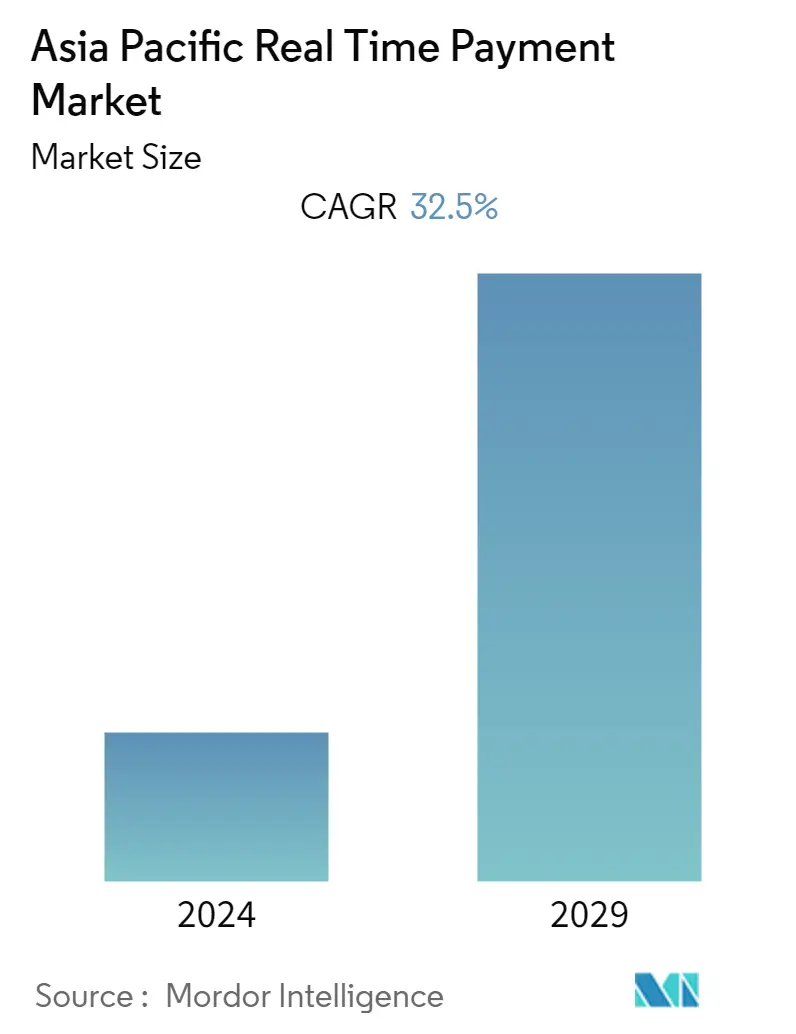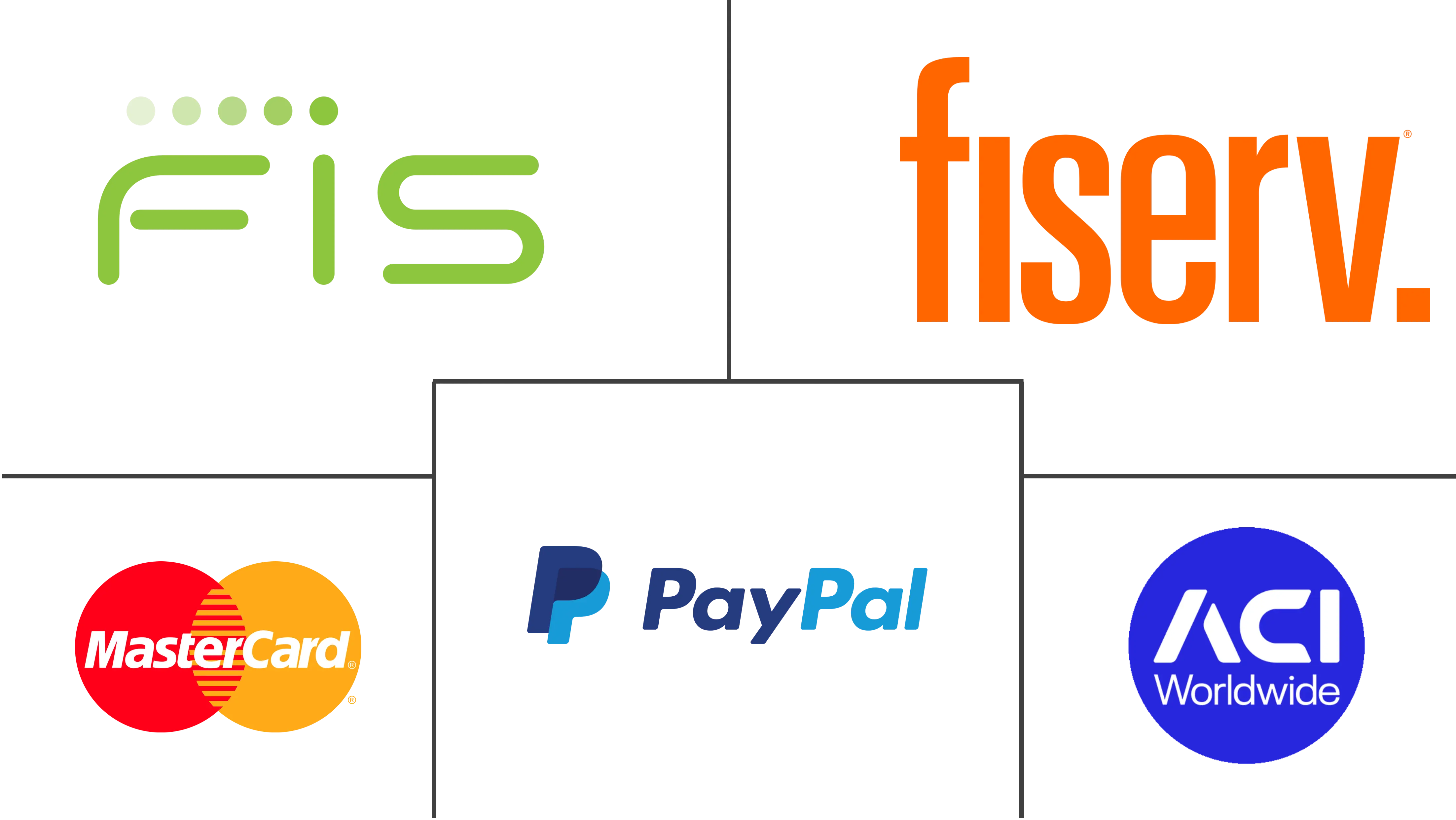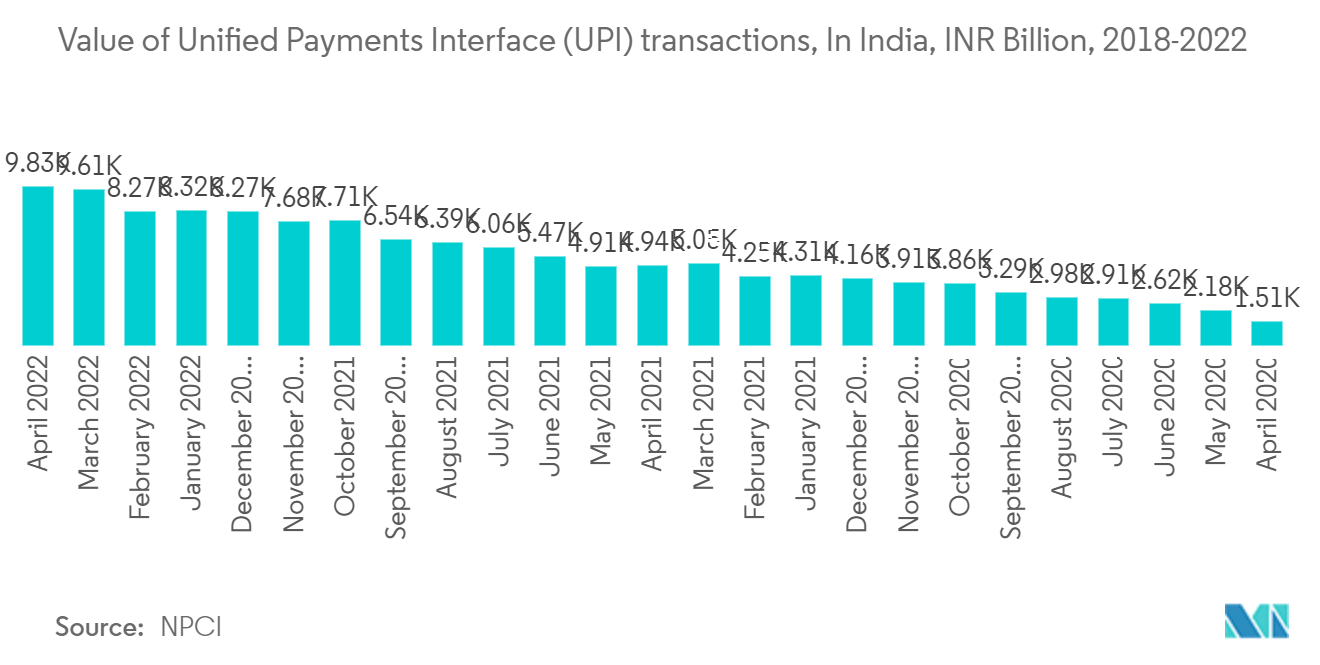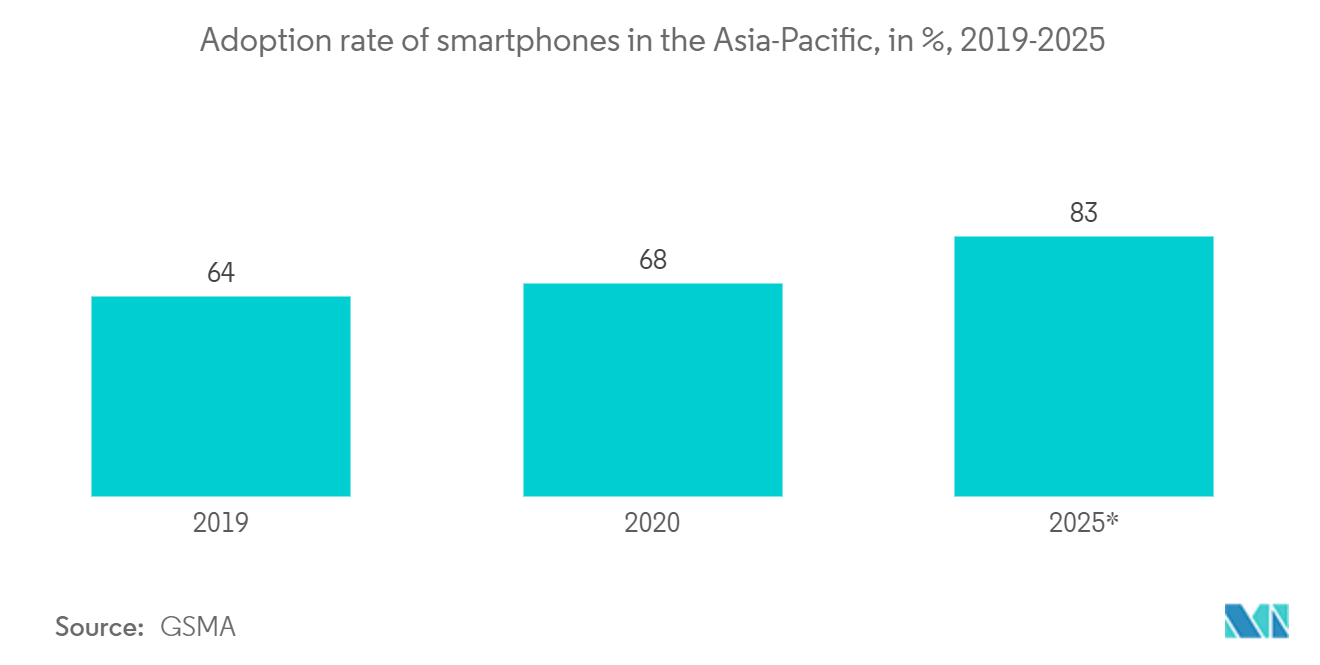APAC Real Time Payment Market Size

| Study Period | 2019 - 2029 |
| Base Year For Estimation | 2023 |
| Forecast Data Period | 2024 - 2029 |
| Historical Data Period | 2019 - 2022 |
| CAGR | 32.50 % |
| Market Concentration | Medium |
Major Players
*Disclaimer: Major Players sorted in no particular order |
APAC Real Time Payment Market Analysis
Asia Pacific Real-Time Payment Market is expected to grow by 32.5% CAGR in the forecasted period. The growing number of smartphone users around the region and the faster transaction speeds compared to alternative methods are propelling the market forward. Over the forecast period, increased acceptance of real-time payment solutions among retailers and retail shop owners is expected to boost market expansion. Although, cybersecurity worries and the difficulties encountered during financial transfers are two factors that may have a detrimental impact on market growth.
- Consumers, businesses, and governments in emerging nations such as India, China, Thailand, Vietnam, etc., are adopting quick payments to gain greater ease and financial security, driving up demand for the solutions.
- The market is primarily supported by the growing use of cell phones worldwide and the ever-increasing desire for quick clearing and reimbursement of money transactions between vendors and purchasers. Furthermore, the market is predicted to develop due to the growing acceptance of real-time payment solutions by web-based business sellers and retail location owners. These systems offer advantages such as faster transaction speeds than other electronic techniques, real-time communications, extensive data transactions, and vendor and corporate organization accessibility 24 hours a day, seven days a week.
- Additionally, rising volumes of cashless transactions and a growing shopper preference for systems like net and mobile banking will add to industry expansion. Due to the increasing popularity of FinTech administrations such as Samsung Pay, Google Pay, and Apple Pay, the industry is likely to grow significantly. Furthermore, expanding the combined efforts of these services/service organizations and regional banks to launch advancements, such as the provision of speedy advances and money-less payments, would accelerate the industry even further.
- According to ACI Worldwide and the Centre for Economics and Business Research's research, Globaldata's Prime-Time for Real-Time 2022, (Cebr). Thailand was the fourth-largest country in the world regarding real-time transactions, with 9.7 billion. In 2021, widespread adoption of real-time payments was expected to save businesses and consumers USD 1.3 billion, resulting in USD 6 billion in additional economic production, representing 1.12% of the country's GDP.
- Lockdowns imposed as a result of COVID-19 enhanced e-commerce and food apps, driving the real-time payments business as well. Real-time payments, for example, accounted for 31.3 percent of overall payments transaction volume in India in 2021, according to ACI, owing to merchant acceptance of UPI-based mobile payment apps and QR code payments, as well as increasing use of digital payments during the Covid-19 outbreak.
APAC Real Time Payment Market Trends
This section covers the major market trends shaping the APAC Real Time Payment Market according to our research experts:
India to lead in terms of Volume of Transactions and economic growth
- According to a survey by ACI, real-time payments are expected to enhance India's GDP by USD 45.9 billion in 2026, with real-time payments transaction volumes expected to top 206 billion by then.
- According to an ACI estimate, India accounted for 48.6 billion real-time transactions in 2021, over three times that of China (18 billion transactions) and nearly seven times that of the United States, Canada, the United Kingdom, France, and Germany (7.5 billion).
- Real-time payments accounted for 31.3% of overall payments transaction volume last year, thanks to merchant adoption of UPI-based mobile payment apps and QR code payments and increased use of digital payments during the Covid-19 outbreak. Real-time payments' proportion of overall payments volume is expected to climb to over 70% in 2026, as consumers rapidly transition from cash to mobile-based real-time payments, skipping payment cards.
- According to the latest FIS poll, a prominent provider of technology solutions for retailers, banks, and capital markets organizations globally, India's daily real-time transactions have doubled to 41 million due to the COVID-19 pandemic.
- According to a report provided by ACI Worldwide, the Indian real-time payments market is well developed compared to other markets such as the United States, the United Kingdom, Canada, and Australia. The Immediate Payment Service (IMPS) and Unified Payments Interface (UPI), both of which have witnessed considerable usage in recent years, are among India's real-time payments, according to the paper titled "Prime Time For Real-Time 2022." These are also considered to be India's primary drivers of real-time payments.
- The universal payment interface (UPI) transactions in India were estimated to be worth over 9.8 trillion Indian rupees as of April 2022. Although this was a little rise from the previous month, the value of UPI transactions had climbed significantly from August 2018, when it was less than 550 billion Indian rupees. UPI was a National Payments Corporation of India (NPCI) platform introduced in 2016. It allows users of payment service providers like PhonePe or GooglePay to connect with banks and transfer money using NPCI as a switch. It's easier to utilize than earlier transaction methods like IMPS.

Increased Smartphone and Internet Penetration to drive the Market
- Smartphones have become the most popular device in India and globally due to the continual need to be connected. People, especially those who live in urban areas and have hectic lifestyles, have become accustomed to communicating on the go. Smartphone ownership is no longer a luxury, thanks to increased disposable income levels and simple financing options (such as EMI). This is a reality for a new country with a huge working population, such as India. Furthermore, tight rivalry among handset manufacturers and technological advancements continue to drive down smartphone prices, increasing affordability and sales growth.
- Operators around the Asia Pacific are leveraging the scale and utility of mobile networks and services to help large and small businesses implement new digital solutions in accordance with Industry 4.0 goals, in which 5G and IoT will play significant roles. In the area, the second wave of 5G network rollouts has commenced, with several 5G-related activities taking place in India, Indonesia, and Malaysia.
- The introduction of 5G in some of these markets could encourage the mass manufacture of more affordable 5G devices for lower-income users and the development of novel 5G applications for consumers and businesses in emerging markets. By the end of 2025, 5G will have surpassed 2G and 3G in total mobile connections, accounting for 14% of all connections, according to the GSMA Mobile Economy Report 2021.
- Connectivity will be critical in rebuilding economies and making them more resilient to future shocks as the Asia Pacific continues to deal with and eventually emerge from the pandemic. 5G networks, cloud services, edge computing, AI, big data, and the Internet of Things will all play a crucial part in realizing the full potential of a post-pandemic digital economy, boosting the real-time payments market.
- The usage of a mobile phone for money transfer is now not only acceptable but also the new normal throughout the Asia Pacific. AliPay and WeChat Pay in China, PayTM in India, OVO, ShopeePay, LinkAja, and GoPay in Indonesia, LINE Pay in Japan and Taiwan, Kakao Pay in South Korea, GrabPay in Malaysia and Singapore, and Gpay and Paytm in India are among the market leaders.

APAC Real Time Payment Industry Overview
The Asia-Pacific Real Payment Market is competitive owing to the presence of various regional players. With quickly changing customer preferences, the market has become a lucrative choice, attracting a large amount of investment. Because of the enormous development potential, the market is fragmenting due to new entrants. To encourage product innovation, service providers are forming alliances.
- In January 2022 - NPCI International Payments Limited (NIPL), the international payments arm of the National Payments Corporation of India (NPCI), has signed a memorandum of understanding with TerraPay, a Netherlands-based global payments infrastructure company, to enable Indians with an active UPI ID to receive real-time, international payments into their bank accounts via TerraPay's secure payments technology.
- January 2022 - MoneyGram International, Inc., a global leader in the growth of digital P2P payments, has announced a strategic relationship with Digital Wallet Corporation. This global fintech firm owns Smiles Mobile Remittance (Smiles), Japan's largest mobile money transfer service and digital wallet. Consumers in Japan may now send money to more than 200 countries and territories worldwide using the Smiles mobile app, which is backed by MoneyGram's global payment rails and near real-time capabilities.
APAC Real Time Payment Market Leaders
-
ACI Worldwide
-
Fiserv
-
PayPal
-
Mastercard
-
FIS
*Disclaimer: Major Players sorted in no particular order

APAC Real Time Payment Market News
- June 2021 - Thailand's first and oldest bank, Siam Commercial Bank (SCB), and Thunes, a global leader in cross-border payments, have launched a partnership that will allow people and businesses from around the world to send money to Thailand faster, cheaper, and with higher transaction limits. Locals and expats in Thailand will soon be able to receive rewards in real-time from all over the world directly into their bank accounts.
- July 2021 - Ripple, the world's leading provider of enterprise blockchain and cryptocurrency solutions for global payments, has announced the launch of RippleNet's first live On-Demand Liquidity (ODL) service implementation in Japan, in partnership with SBI Remit Co., Ltd, Japan's largest money transfer provider and one of the Philippines' most popular mobile wallet services. The launch aims to propel the Philippines and the rest of the region into the next frontier of financial innovation beyond real-time payments.
APAC Real Time Payment Market Report - Table of Contents
1. INTRODUCTION
1.1 Study Assumptions and Market Definitions
2. RESEARCH METHODOLOGY
3. EXECUTIVE SUMMARY
4. MARKET INSIGHTS
4.1 Market Overview
4.2 Industry Attractiveness-Porter's Five Force Analysis
4.2.1 Bargaining Power of Suppliers
4.2.2 Bargaining Power of Buyers/Consumers
4.2.3 Threat of New Entrants
4.2.4 Threat of Substitute Products
4.2.5 Intensity of Competitive Rivalry
4.3 Evolution of the payments landscape in the country
4.4 Key market trends pertaining to the growth of cashless transaction in the Region
4.5 Impact of COVID-19 on the payments market in the country
5. MARKET DYNAMICS
5.1 Market Drivers
5.1.1 Increased Smartphone Penetration
5.1.2 Falling Reliance on Traditional Banking
5.1.3 Ease of Convenience
5.2 Market Challenges
5.2.1 Payment Fraud
5.2.2 Existing Dependence on Cash
5.3 Market Opportunities
5.3.1 Government Policies Encouraging the Growth of Digital Paymentis expected to aid the growth of Real Time Payment methods amongst commoners
5.4 Key Regulations and Standards in the Digital Payments Industry
5.4.1 Regulatory Landscape Across the World
5.4.2 Business Models with Potential Regulatory Roadblocks
5.4.3 Scope for Development in Lieu of Evolving Business Landscape
5.5 Analysis of major case studies and use-cases
6. Market Segmentation
6.1 By Type of Payment
6.1.1 P2P
6.1.2 P2B
6.2 Asia Pacific
6.2.1 China
6.2.2 India
6.2.3 Japan
6.2.4 South Korea
6.2.5 Rest of the Asia Pacific
7. COMPETITIVE LANDSCAPE
7.1 ACI Worldwide Inc.
7.2 Fiserv Inc.
7.3 Paypal Holdings Inc.
7.4 Mastercard Inc.
7.5 FIS Global
7.6 VISA Inc.
7.7 Apple Inc.
7.8 Alipay (Ant Financials)
7.9 SIA SpA
7.10 Finastra
8. Investment Analysis
9. Future Outlook of the Market
APAC Real Time Payment Industry Segmentation
Real-time payments are instant or immediate payments and are defined by the Euro Retail Payments Board (ERPB) as electronic retail payment solutions that are available 24/7/365. Immediate payments enable businesses and consumers to make and receive payments in real-time, providing convenience, speed, and faster availability of funds.
Asia Pacific Real-Time Payment Market is segmented by Type (P2P, P2B) and by Country (China, India, Japan, South Korea, and the Rest of the Asia-Pacific).
| By Type of Payment | |
| P2P | |
| P2B |
| Asia Pacific | |
| China | |
| India | |
| Japan | |
| South Korea | |
| Rest of the Asia Pacific |
APAC Real Time Payment Market Research FAQs
What is the current Asia Pacific Real Time Payment Market size?
The Asia Pacific Real Time Payment Market is projected to register a CAGR of 32.5% during the forecast period (2024-2029)
Who are the key players in Asia Pacific Real Time Payment Market?
ACI Worldwide, Fiserv, PayPal, Mastercard and FIS are the major companies operating in the Asia Pacific Real Time Payment Market.
What years does this Asia Pacific Real Time Payment Market cover?
The report covers the Asia Pacific Real Time Payment Market historical market size for years: 2019, 2020, 2021, 2022 and 2023. The report also forecasts the Asia Pacific Real Time Payment Market size for years: 2024, 2025, 2026, 2027, 2028 and 2029.
Asia Pacific Real Time Payment Industry Report
Statistics for the 2024 Asia Pacific Real Time Payment market share, size and revenue growth rate, created by Mordor Intelligence™ Industry Reports. Asia Pacific Real Time Payment analysis includes a market forecast outlook to 2029 and historical overview. Get a sample of this industry analysis as a free report PDF download.



